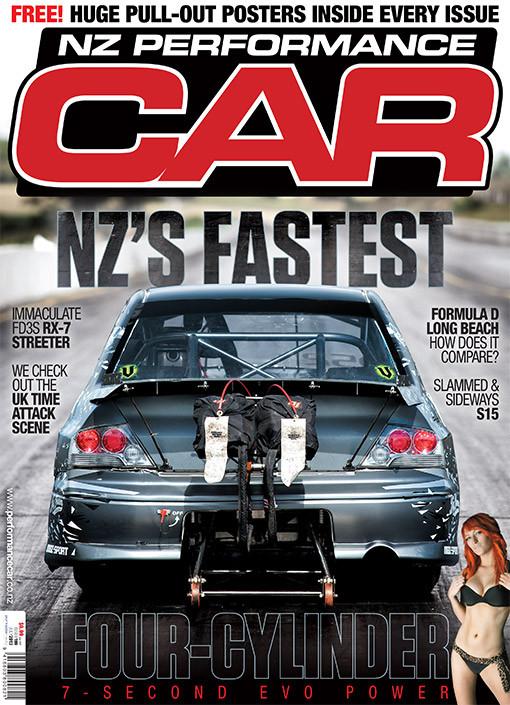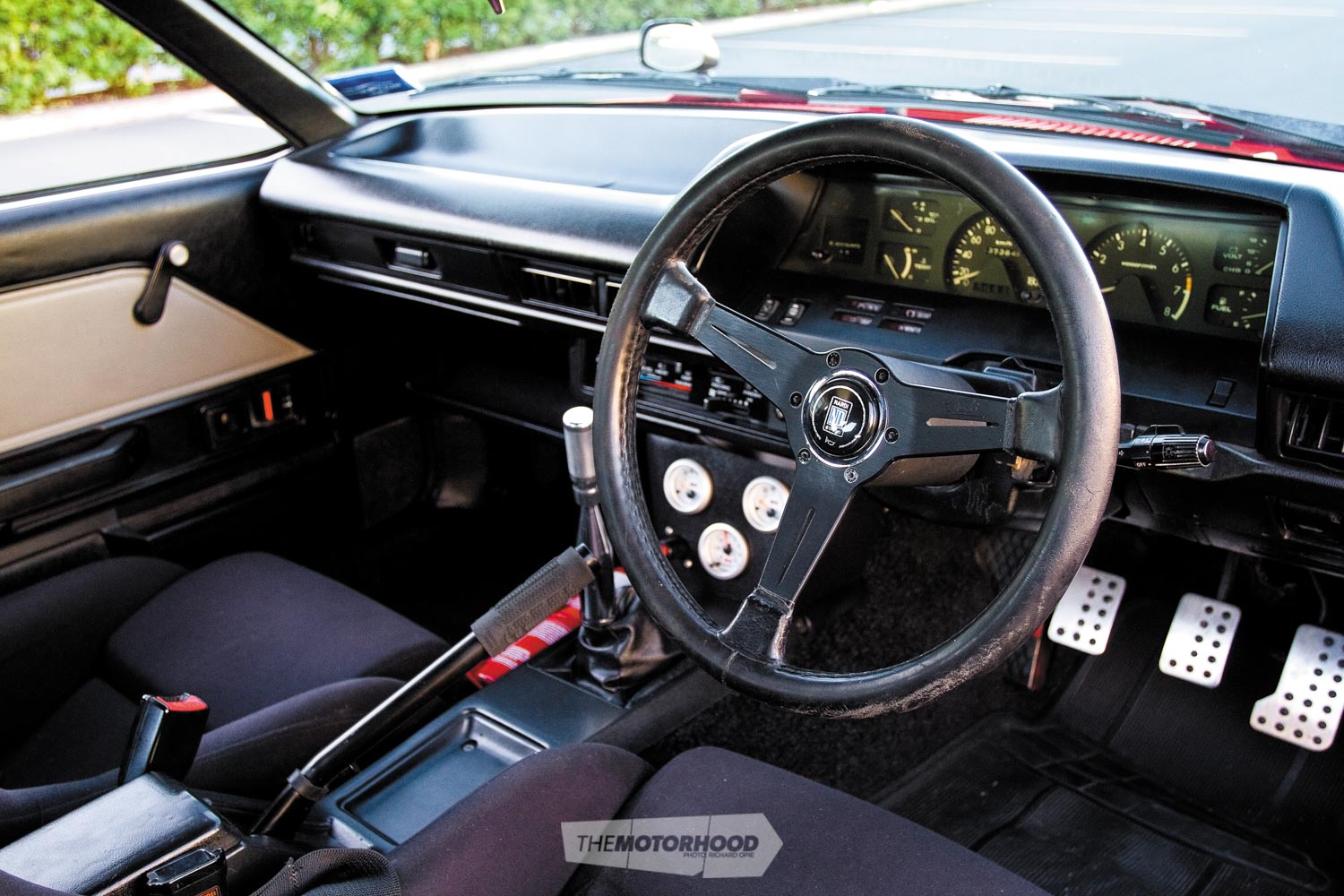This TE71 Trueno proves the ’80s have never looked fresher
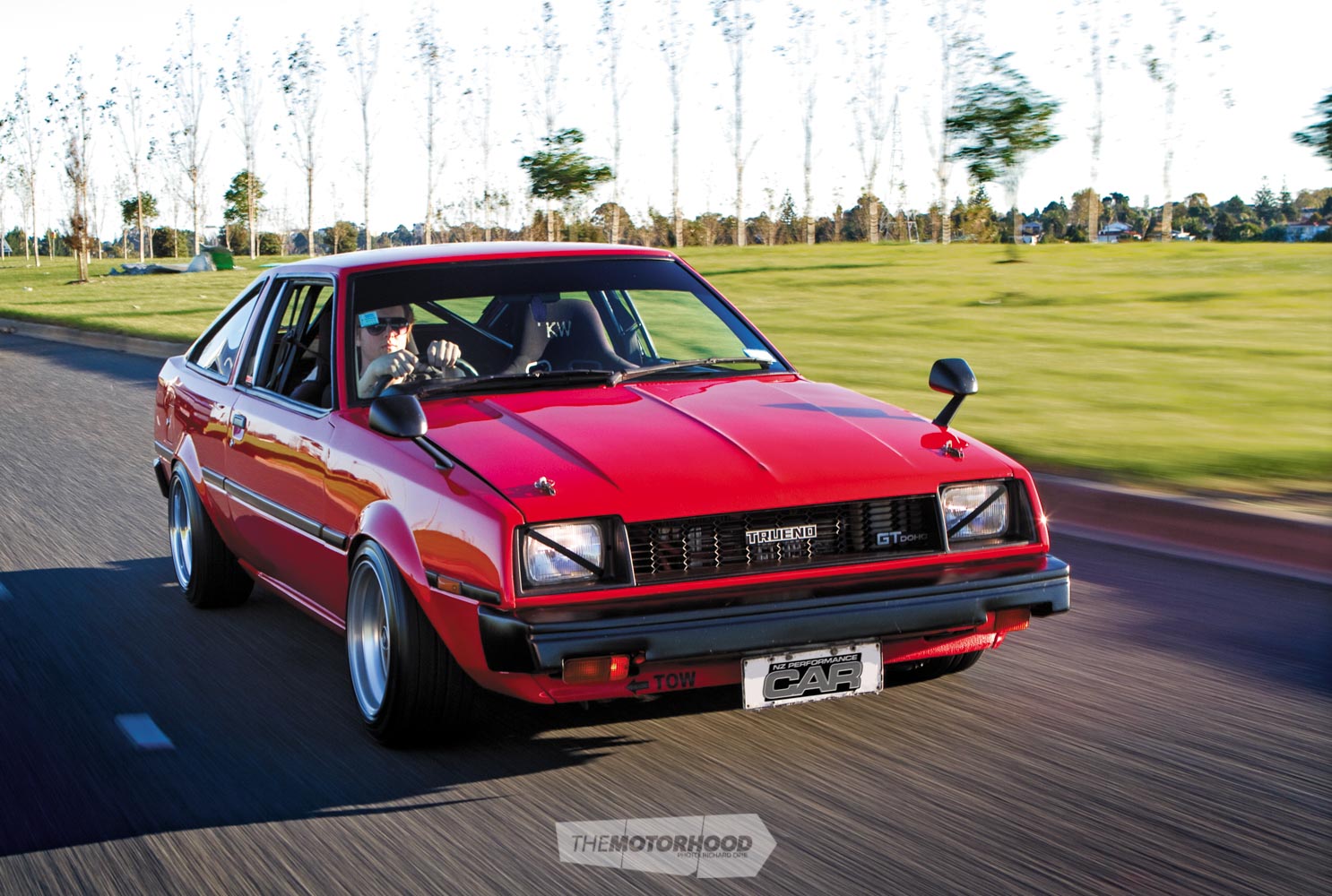
Across the 120-odd years the car has been driving the planet’s roads the same simple premise — four wheels motivated by an internal combustion engine — has remained, and the one thing that has evolved with time and fashion is styling. From the elegance of 1930s curves, to the glamour of 1950s jet-age fins and chrome, through to the restraint of the 1970s, each decade asserted itself through very distinct design idiosyncrasies.
Then along came the 1980s and car designers the world over consigned the French curve to the trash, instead employing the trusty ruler to scribe the arrow-straight lines of their latest offerings.
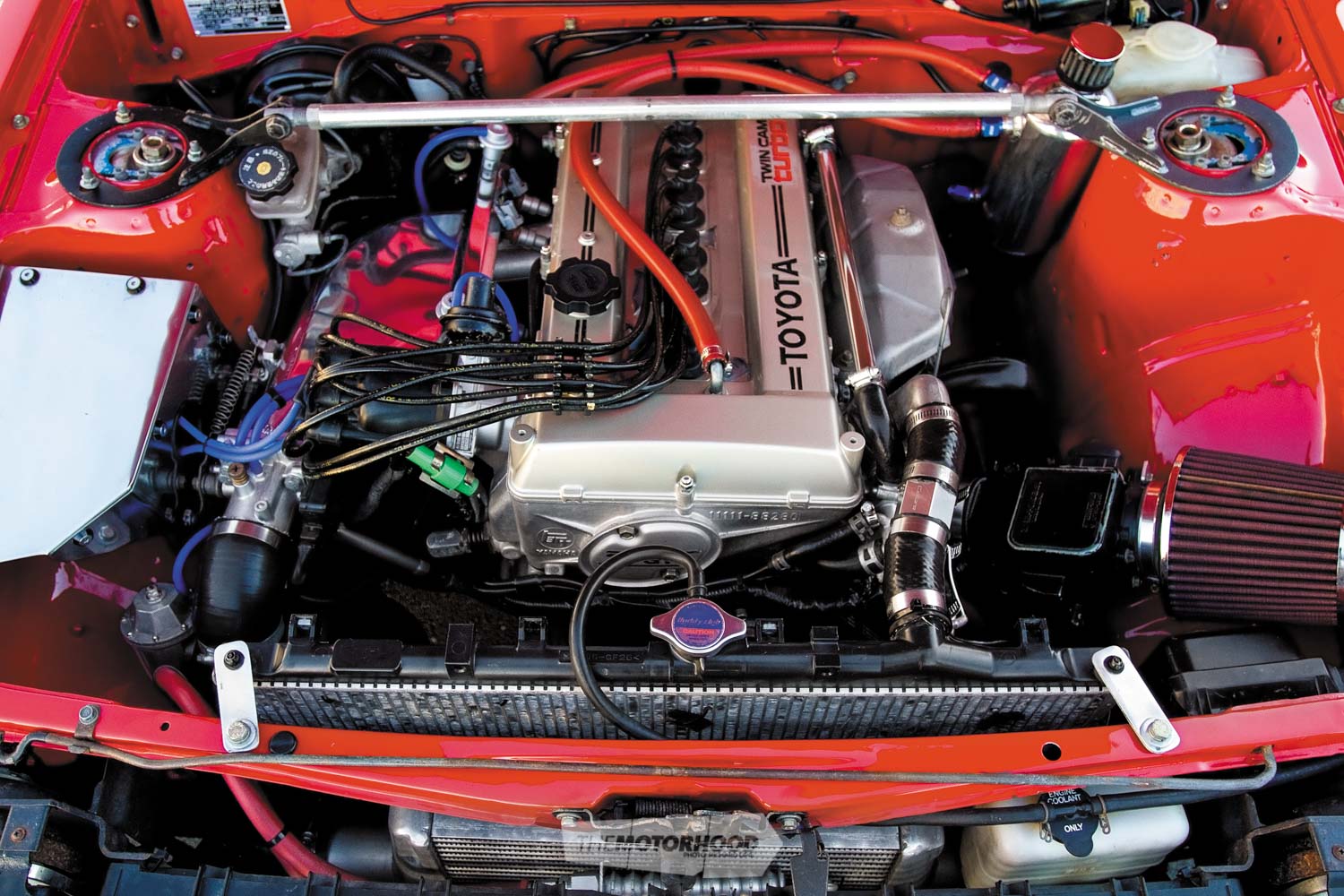
In a not-so-common move, the Trueno runs a suitably ’80s 3T-GTE 1800cc four-cylinder, complete with twin spark head, eight huge valves and a CT20 turbo
The rakish angles of the 1980s don’t come much more evident than on panel beater John Franich’s 1981 TE71 Toyota Sprinter Trueno GT, the precursor to the much easier on the eye AE86, and possessor of some of the most 1980s-typical styling you’ll find. Not that it matters to John, who three years ago uncovered the rakish coupé in a condition common to many cars built of 1980s Japanese steel. He parted ways with his fully panelled-and-painted twin-headlight KE70 sedan to acquire the TE71 “with all its rust patches and primer … I guess that [appeal] lies in the eye of the beholder”. What John did know when he discovered the rare Sprinter was exactly how the project would culminate. “Some of my influence has come from the Motorfix KE70s, but I’ve always just loved the look of square-bodied ’80s cars … low with wide rims, good offset and guard mirrors.” It was with all this in mind that the project began.
As things eventuated, a career in the panel beating trade was a wise move, as the modest $500 initial outlay for the Trueno meant John definitely got what he paid for: “To be honest it looked like it should have belonged in a wrecker, with the bottoms of the guards gone, both rear quarters, rust holes in the roof … it leaked like a sieve!” Looking at the pin-sharp lines of the Trueno now, it’s hard to imagine it once narrowly escaped the crusher. Hours of John’s time was poured into ensuring the car is structurally sound, and the deep gloss of the Toyota British Red paint cloaks its panels and angles to full effect.
To accommodate the wider wheels he planned, John pulled the guards out almost 50mm, being careful to retain near-factory lines for that all-important subtlety. Thankfully, things weren’t so bad beneath the bonnet, with the old-school 2T-GEU still humming away as heartily as Toyota had intended back in 1981. John wanted instant speed gratification, so on went a backyard-concocted turbo set-up to wedge some boost down the 1600’s ports. Like many hasty builds undertaken in the pursuit of power, this didn’t last too long as the 2T cried enough after a spot of thrashing, which opened the door for the TE71’s current powerplant.
John kept things firmly in the Toyota T family, and opening the bonnet reveals the ultimate production version of the T-series engine, the 3T-GTE. Like many 1980s Japanese performance motors, the 3T-GTE was engineered tough. In the interests of reliability, however, John carefully rebuilt the 1.8 twin-cam turbo lump’s internals to stock spec, treating it to new rings, bearings and gaskets/seals to ensure it can take a beating when needed. A larger 2T-GEU throttle body feeds a custom fabricated and polished plenum, which hangs off the driver’s side of the wide twin-cam head, while on the exhaust side things remain close to standard, with a CT20 turbo bolted to a stock manifold that shoves 12psi of boost through the front-mounted GTi-R Pulsar intercooler.

Tucked beneath the rear guards is a pair of three-piece Work Equip 01 wheels measuring 14×8 inches and restored to gleaming perfection
Besides the picture-perfect paintwork, the most visually striking aspect of the exterior comes courtesy of John’s choice in retro rolling stock. Tucked beneath the rear guards is a pair of three-piece Work Equip 01 wheels measuring 14×8 inches and restored to gleaming perfection, while at the pointy end there is a pair of Techno Racing TR-Vs, also in 14×8-inch flavour, taking care of direction.
To provide the all-important drop over the wheels, John employed the Toyota-Lego system, bolting in a set of heavily modified GX71 Cressida front struts containing damper-adjustable GAB inserts, and using a larger front sway bar from a Corona. Adjustable height platforms and a pair of Cusco camber plates ensure suspension geometry is spot on, while the Cressida’s 254mm vented rotors haul the Trueno to a stop time and time again. Rear-end duties are the specialty of a four-link standard T-code rear axle, with Nolathane bushes throughout ensuring the 32-year-old chassis is as taut and responsive as ever.

The 1980s never looked so good. Toyota parts-bin suspension hunkers the Trueno over small-diameter wide wheels for an authentic Japanese touge-basher stance
The eye-catching hue, slammed ride height and wide wheels may scream party on the outside but in the cabin, it’s all business. Twin KW fixed-back seats hold both driver and passenger snugly in place, while a Nardi classic steering wheel is positioned between John and the squared-off dashboard for steering duties. A custom centre console houses a trio of gauges to keep the 3T-GTE in check. To round off the innards there’s a half cage which neatly ties the stripped-out back end of the car together, with John opting to relocate the battery to the boot in the interests of weight distribution.
It’s rare to meet an owner who considers a project build finished, but John explains he has no further plans for the TE71: “I’m happy with it exactly how it is, I love driving it and especially the attention and looks it gets.” Meanwhile, in the shed nearing completion there’s a second TE71, this time with a pure race focus to prove that in 2013, more than ever, it’s totally hip to be square.

John Franich
Age: 24
Location: Auckland
Occupation: Panel beater
Build time: Three years
Length of ownership: Six years
Thanks: Mum and Dad, my girlfriend Freyan, Daniel Franich, Alan Parfitt at Morrow Auto Electrical for late nights wiring and fixing my mistakes, Tim Hoffman at Honda Cars East Auckland for the paint, Nick at Repco, all the boys at work, and the neighbours for putting up with the late nights and noise!
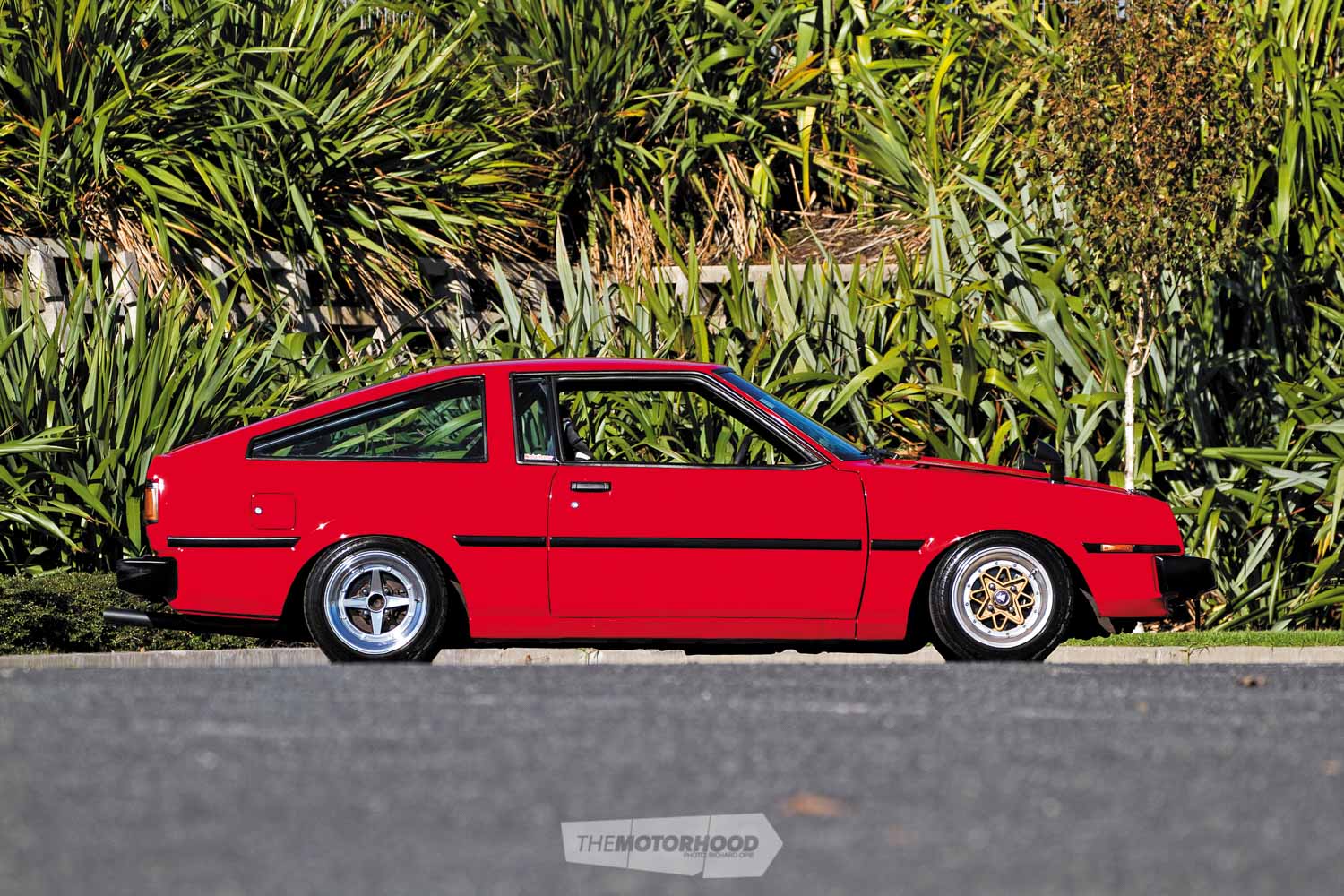
Heart:
Engine: 3T-GTE 1800cc four-cylinder
Block: Stock, fully reconditioned
Head: Standard twin spark head
Intake: Custom stainless inlet plenum, 2T-GTE throttle body, Pulsar GTi-R intercooler, custom piping
Turbo: Toyota CT20 with stock wastegate
Exhaust: Standard manifold, custom dump pipe into 2.5-inch exhaust
BOV: HKS
Fuel system: 4AGZE 365cc injectors, Walbro 500hp pump
Ignition system: Stock Toyota twin spark
Engine management: Stock 3T-GTE ECU
Cooling: Camry radiator, RX-7 oil cooler
Extras: M&H catch-can with push lock fitting, custom stainless steel coil and ignitor cover
Driveline:
Gearbox: Toyota T50 five-speed
Diff: Toyota T-code 4.11:1
Support:
Struts: (F) Cressida front struts, GAB adjustable inserts, height-adjustable platforms, Cusco camber plates;
(R) HKS height- and damper-adjustable shocks
Springs: (F) JIC; (R) Tein
Brakes: (F) GX71 Cressida 10-inch vented rotors;
(R) stock
Other: KE70 steering rack conversion, front and rear strut braces, Nolathane four-link, sway bar and castor arm bushes, adjustable Panhard rod, Corona front sway bar, adjustable rose-jointed LCAs
Shoes:
Wheels: (F) 14×8-inch Techno Racing TR-V; (R) 14×8-inch Work Equip 01
Tyres: 185/55/14 Bridgestone Potenza RE01
Exterior:
Paint: Toyota British Red
Enhancements: Pumped front and rear arches, fender mirrors
Interior:
Seats: KW fixed-back race seats
Steering wheel: Nardi classic
Instrumentation: Autogauge boost, oil pressure and water temp
ICE: Panasonic head unit, four JVC speakers
Other: Bride bolt-in cage, four-point harnesses, stripped sound deadening
This article originally appeared in NZ Performance Car issue No. 199. Grab yourself a print copy of the mag at the link below:
